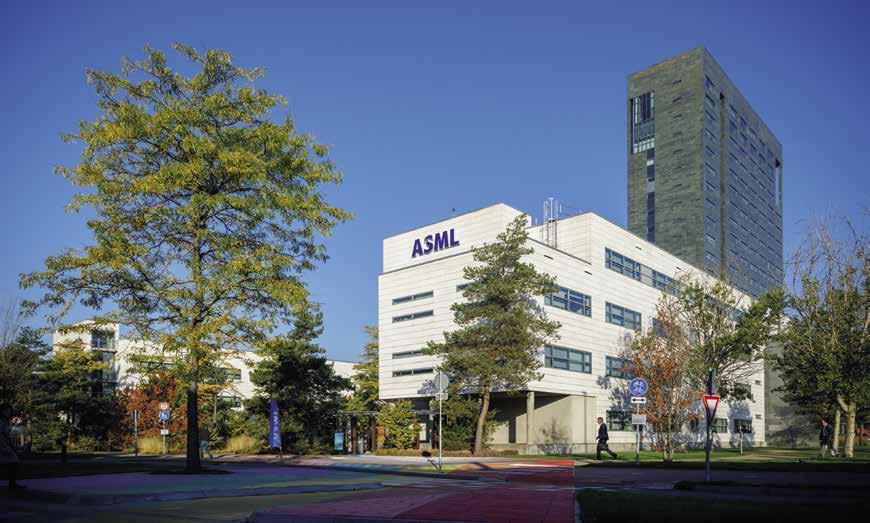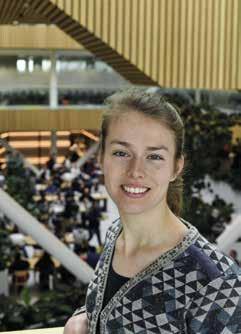
7 minute read
Designing new technology with great colleagues
At ASML, they believe that semiconductor technology is a force for good. It improves how we live, work and play, and it helps to solve some of society’s toughest challenges. ASML produces the most advanced machines in the world, as well as the software needed to run them. Mechanical engineers, electrical engineers, computer scientists, mathematicians and physicists are faced with the challenge of achieving the impossible. That’s why they are given responsibility, ownership and freedom to do exactly what they believe can make a difference.
Eline de Jong is an Optical Sensors Design Engineer. After completing her bachelor in Natural Sciences in Nijmegen, she decided to do a master in Applied Physics at TU Eindhoven. She knew that she wanted to stay in physics afterwards, but she wasn’t sure how exactly because there was so much choice. During her bachelor, she had been in contact with ASML a couple of times. “ASML had always made a good impression on me, so I started looking into the possibilities for me within the company. I knew someone who worked here and they wrote a recommendation for me. I immediately got a good feeling about ASML. If you attend four interviews and you experience a click with everyone you speak to, then you know that it’s a good match. You meet with people who you’ll subsequently be working with every day, so I regard that click as very important.”
Advertisement
Now, two years later, Eline is still working in the same place. She is in a team of 15 people, in a department comprising four such teams. “This role is perfect for me. It’s natural to want to do something different in the longer term, of course, but I believe you need to allow yourself enough time to grow into your role to become really good at your job – especially here, where you can go into so much technical depth and can learn something new every day. Our team works on physics and software. In our department, we design image sensors which are then produced by suppliers, and we subsequently qualify them. We write scripts for machine testing (in Python), and we analyse the results in Matlab. We also solve issues with the current sensors. Primarily, we work on the future generation of sensors. We explore new opportunities, but we never lose sight of the feasibility and applicability. That’s why we have a lot of contact with the software group, the mechanical department and the electronic department, as well as with suppliers. We have to work within a certain framework. Besides that, any new design must contain all the current functionalities. We do as much testing as possible offline, in simulations, because machine time is expensive.”
“What I love about this job is the technical nature of the work. Testing designs, seeing the results and, if it doesn’t work, figuring out what exactly is going on. And if it does work, then you investigate whether it will work every time, how it can be further improved, and doublecheck whether there are any negative consequences. That’s what I enjoy most: starting from scratch on something that doesn’t exist yet and ending up with something that works well in the machine. Here, I’ve found exactly what I had in mind during my studies – partly thanks to the technical challenge, but above all thanks to the colleagues. We work in the Scaled Agile Framework (SAFe), which means we divide the work up into two-week sprints. Our Mondays are usually for meetings, evaluation and planning ahead.”
“We have lots of intelligent people working here. The attitude is that you can always find a way to make something work, even if it doesn’t work at first. It might seem impossible, but because all your colleagues and all the other teams share the same spirit, you always succeed eventually. And we’re not only focused on optimization when developing new technology; we’re also continuously improving the production processes, such as by thinking about how we can reuse components or how we can make the transport more efficient and more sustainable. You won’t find that in your job description, but it’s an important part of the thought process.”
“ASML sometimes places extra demands on your flexibility, but also offers you flexibility in return. For example, although we work with a time-registration system, it’s not a problem if you arrive late or leave early occasionally. It’s the result that counts. And although ASML is big, it has lots of communities you can become part of to get to know people outside of your own team and department. Personally, I’m a member of the runners’ club. As an extra benefit, joining a club helps you to expand your network. Besides that, this is a great place to work: nice buildings, nice workstations and terrific facilities for sport and recreation. Where else would you have your own athletics track on the doorstep?”
5 Tips To Get Your Application Noticed
ASML is eagerly seeking new employees, but it’s nevertheless important that you stand out from the masses of candidates. Here are five tips to get your job application noticed:
1. Show that you understand what ASML does and how you fit in with the company’s core values (‘challenge, collaborate, care’).
2. Present your experience and skills in a clear, concise and convincing manner. List them in reverse chronological order on your CV.
3. Make sure that your motivation letter adds something to your CV – give examples to illustrate your experiences, personality or interests.
4. Don’t just focus on what you expect of ASML and the role you are applying for, but also explain why you’re the perfect match for ASML and your future team.
5. Apply through an early careers program. This way, you apply for multiple roles simultaneously! If you’re hired, you make a contribution through your work, and you also regularly attend sessions to get to know ASML better so that you can settle in as quickly and smoothly as possible.
Watch the video to see what life at ASML looks like for Eline!
ASML is a high-tech company, headquartered in the Netherlands. We manufacture the complex lithography machines that chipmakers use to produce integrated circuits, or computer chips. Over 30 years, we have grown from a small start-up into a multinational company with over 60 locations in 16 countries and regions, 32,000 people of 122 nationalities, and annual net sales of €18.6 billion in 2021.
Behind ASML’s innovations are engineers who think ahead. Our researchers, engineers and manufacturing specialists, as well as our high-tech hardware and software, all work at the edge of what’s possible. That’s why our customers include all the world’s leading chipmakers. Because ASML spends €2.5 billion per year on R&D, our teams have the freedom, support and resources to experiment, test and push the boundaries of technology. They work in close-knit, multidisciplinary teams, listening to and learning from each other.
If you are passionate about technology and want to be a part of progress, visit www.asml.com/careers


Watch the video to see what life at ASML looks like for Eline!

Eline de Jong.





